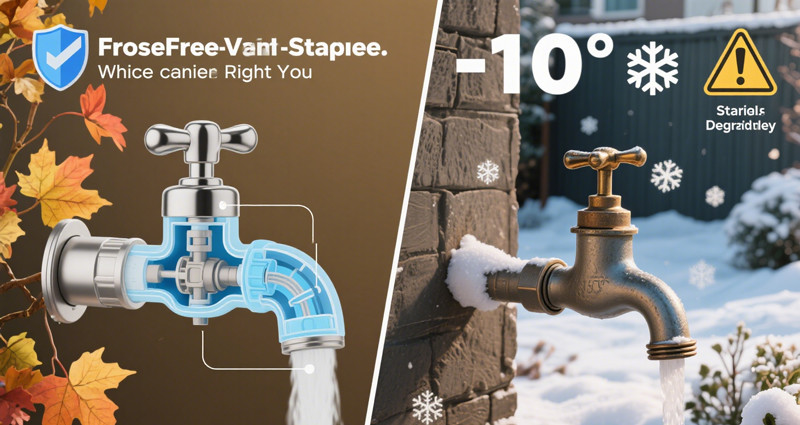Outdoor faucets, also known as hose bibs or spigots, are essential fixtures for tasks like gardening, washing your car, or filling up a pool. But if you live in an area that experiences cold winters, choosing the right type of faucet is crucial—not just for convenience, but to avoid costly water damage.
Two main options dominate the market: frost-free (or freeze-proof) faucets and standard faucets. While they might look similar on the outside, the differences in performance, durability, and climate suitability are significant.
In this article, we’ll explore the key differences between frost-free and standard outdoor faucets, their advantages and disadvantages, and how to choose the best one for your home.
What Is a Standard Outdoor Faucet?
A standard outdoor faucet is the traditional fixture many homes have. It consists of a handle, spout, and a short stem where the valve is located—usually just behind the wall.
How It Works:
When you turn the handle, water flows through the valve at the base and out the spout. Because the shut-off valve is so close to the exterior wall, it’s vulnerable to freezing when temperatures drop.
Pros:
-
Lower initial cost: Standard faucets are typically more affordable.
-
Easy installation: Less complicated than frost-free models.
-
Widely available: Found in most hardware stores and home centers.
Cons:
-
Prone to freezing: If water is left in the pipe and the temperature drops, the pipe can burst behind the wall.
-
Needs winterization: In cold climates, homeowners must manually shut off and drain the line every fall.
What Is a Frost-Free Outdoor Faucet?
A frost-free faucet is designed to prevent freezing even in below-freezing temperatures. Its key difference is the location of the shut-off valve.
How It Works:
In a frost-free design, the valve is located farther inside the house—often 8 to 12 inches behind the wall—where the temperature remains above freezing. When you turn off the faucet, water drains out of the exposed pipe, leaving nothing behind to freeze.
Pros:
-
Freeze protection: Ideal for cold climates; reduces risk of burst pipes.
-
Low maintenance: No need to winterize (as long as hoses are removed).
-
Long-term reliability: Saves money by preventing water damage and repair costs.
Cons:
-
Higher cost: Frost-free faucets can be more expensive upfront.
-
Complex installation: Requires proper sloping and space behind the wall.
-
Improper use can defeat purpose: Leaving a hose connected can trap water in the pipe, making it vulnerable to freezing.
Key Differences at a Glance
| Feature | Standard Faucet | Frost-Free Faucet |
|---|---|---|
| Freeze Protection | No | Yes |
| Shut-off Valve Location | Just behind the wall | Deep inside the house |
| Maintenance Required | Must be winterized manually | Minimal (remove hoses in winter) |
| Cost | Lower | Slightly higher |
| Installation | Simple | Requires proper slope and space |
When to Use a Standard Faucet
Standard faucets can be perfectly acceptable if you:
-
Live in a warm climate with no risk of freezing
-
Want a simple and inexpensive solution
-
Plan to replace or upgrade your faucet soon and don’t want to invest heavily
If you’re using a standard faucet in a colder region, you must install a separate interior shut-off valve and drain the line before winter to prevent freezing.
When to Choose a Frost-Free Faucet
If you live in a region with freezing winters, a frost-free faucet is a smart investment. It can:
-
Prevent expensive pipe bursts and water damage
-
Save time on seasonal maintenance
-
Increase your home’s resale value with modern upgrades
It’s also the right choice for vacation homes or rental properties, where you may not be around to perform winter maintenance.
Installation Tips and Considerations
Whether you’re installing a standard or frost-free faucet, there are some best practices to follow:
1. Slope Matters (Especially for Frost-Free Faucets)
Ensure the pipe slopes downward toward the outside. This allows water to drain out when the faucet is turned off.
2. Use Pipe Insulation for Added Protection
In very cold regions, you can pair frost-free faucets with insulated covers or wrap the interior pipe with foam insulation for extra peace of mind.
3. Check Hose Connections
Even a frost-free faucet can freeze and burst if a hose or Y-connector is left attached during the winter. Always disconnect and drain hoses before the first freeze.
4. Install a Vacuum Breaker or Anti-Siphon Valve
Many modern frost-free faucets include this built-in. It prevents backflow of contaminated water into your home’s water supply—a valuable safety feature.
Common Myths About Outdoor Faucets
Myth 1: “Frost-free faucets can’t freeze.”
They can if the slope is wrong, or if a hose is left attached. Proper installation and use are key.
Myth 2: “You only need to winterize if it gets below 0°F.”
Water begins to freeze at 32°F. Even a mild frost can damage an unprotected pipe.
Myth 3: “Standard faucets are just as good if you shut them off inside.”
While that helps, it’s not foolproof unless the line is also drained.
Final Verdict: Frost-Free vs. Standard
If you live in a warm climate and want a quick, low-cost faucet solution, a standard outdoor faucet is perfectly adequate. But if there’s even a small chance of freezing temperatures where you live, a frost-free faucet is worth the investment.
It not only protects your home from water damage but also saves time and worry during the winter season. With proper use and installation, a frost-free faucet can last for years with minimal maintenance.
Conclusion
Choosing between a frost-free and standard outdoor faucet depends largely on your local climate, usage habits, and willingness to maintain it. While the standard faucet may be fine in sunny states like Florida or Southern California, frost-free models are the smart, secure choice for homeowners in temperate and cold climates.
As with most home improvements, doing it right the first time can prevent a lot of headaches later. So next time you’re replacing your outdoor faucet, ask yourself: Is it just a tap—or a tool for year-round peace of mind?








